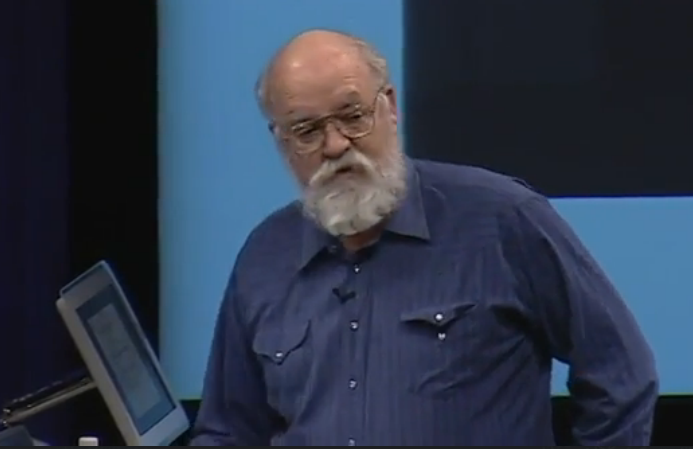The artist had very cleverly suggested people and clothes and wagons and all sorts of things,
藝術(shù)家很聰明地暗示了人物和服裝,以及車馬還有其他事物,
and my brain had taken the suggestion.
而我的大腦接受了這樣的暗示。
You're familiar with a more recent technology, which is -- There,
你們很熟悉一個(gè)更新的技術(shù),就在--這個(gè)。
you can get a better view of the blobs.
你們可以更好地看到顆粒。
See, when you get close they're really just blobs of paint.
看,當(dāng)你移近時(shí),他們就真的只是顏料粒。
You will have seen something like this -- this is the reverse effect.
你應(yīng)該看過像這樣的東西——相反的效果。
I'll just give that to you one more time.
我再來演示一次。
Now, what does your brain do when it takes the suggestion?
好,那么當(dāng)你的大腦接受暗示時(shí)他做了什么呢?
When an artful blob of paint or two, by an artist, suggests a person
當(dāng)藝術(shù)家的一兩滴顏料粒暗示了一個(gè)人
say, one of Marvin Minsky's little society of mind
比如,一個(gè)Marvin Minsky的小社會(huì)心態(tài)
do they send little painters out to fill in all the details in your brain somewhere?
難道他們把小畫家送到你的腦子里來填充所有細(xì)節(jié)?

I don't think so. Not a chance. But then, how on Earth is it done?
我覺得不是。沒有任何可能,不過那樣的話,那這些又到底是怎么回事?
Well, remember the philosopher's explanation of the lady?
還記得哲學(xué)家怎么解釋那個(gè)被鋸成兩半的女士嗎?
It's the same thing.
這是同一件事情。
The brain just makes you think that it's got the detail there.
大腦只是讓你確信它得到了那處細(xì)節(jié)。
You think the detail's there, but it isn't there.
你想著細(xì)節(jié)在那里,但是他不在。
The brain isn't actually putting the detail in your head at all.
大腦并沒有把細(xì)節(jié)放入腦海中。
It's just making you expect the detail.
它只是讓你期待細(xì)節(jié)。
Let's just do this experiment very quickly.
讓我們快速地過下這個(gè)試驗(yàn)。
Is the shape on the left the same as the shape on the right, rotated? Yes.
左邊的形狀旋轉(zhuǎn)后是不是與右邊的完全相同?是的。
How many of you did it by rotating the one on the left in your mind's eye,
多少人把左邊的形狀旋轉(zhuǎn)了,在想象中,
to see if it matched up with the one on the right?
來看它是否與右邊那個(gè)一致?
How many of you rotated the one on the right? OK.
有多少人旋轉(zhuǎn)的是右邊那個(gè)?好的。
How do you know that's what you did?
你怎么知道那就是你所作的?
There's in fact been a very interesting debate raging for over 20 years in cognitive science
實(shí)際上這有個(gè)非常有趣的爭(zhēng)論,在認(rèn)知科學(xué)領(lǐng)域持續(xù)了20年
various experiments started by Roger Shepherd,
由Roger Shepherd開始的各種試驗(yàn),
who measured the angular velocity of rotation of mental images.
他測(cè)量了人的意識(shí)中圖像的旋轉(zhuǎn)角速度。
Yes, it's possible to do that.
是的,這是做得到的。
But the details of the process are still in significant controversy.
但是過程的細(xì)節(jié)還有著明顯的爭(zhēng)議。
And if you read that literature, one of the things that you really have to come to terms with is
如果你閱讀相關(guān)的文獻(xiàn),有件事情你一定要妥協(xié)的是
even when you're the subject in the experiment, you don't know.
即使你是實(shí)驗(yàn)對(duì)象,你也無從知道。
You don't know how you do it.
你不知道你是怎么做到的。
You just know that you have certain beliefs.
你只是知道你有特定的信念
And they come in a certain order, at a certain time.
他們?cè)谔囟ǖ臅r(shí)間以特定的順序出現(xiàn)。
And what explains the fact that that's what you think?
那么,如何解釋“那就是你所想的”這個(gè)事實(shí)呢?
Well, that's where you have to go backstage and ask the magician.
那,你就要到后臺(tái)去問魔術(shù)師了。
This is a figure that I love: Bradley, Petrie, and Dumais.
這是我喜歡的圖示:Bradley, Petrie,以及 Dumais。
You may think that I've cheated, that I've put a little whiter-than-white boundary there.
你可能覺得我在騙你,通過放置一些不顯眼的邊界。
How many of you see that sort of boundary, with the Necker cube floating in front of the circles?
多少人看到了那種邊界,通過把內(nèi)克爾方塊放在圓圈的前面?
Can you see it?
你可以看到嗎?
Well, you know, in effect, the boundary's really there, in a certain sense.
看起來,在特定情境下,是有邊界的。
Your brain is actually computing that boundary, the boundary that goes right there.
你的大腦計(jì)算出了那種邊界,讓邊界出現(xiàn)在那里。



